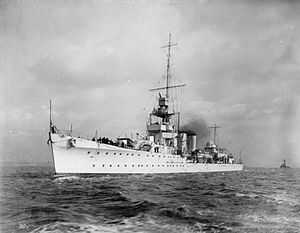HMS Cairo (D87)
 | |
| Career | |
|---|---|
| Class and type: | C-class light cruiser |
| Name: | HMS Cairo |
| Builder: | Cammell Laird |
| Laid down: | 17 November 1917 |
| Launched: | 19 November 1918 |
| Commissioned: | 23 September 1919 |
| Reclassified: | Converted to anti-aircraft cruiser in 1939 |
| Fate: | Sunk 12 August 1942 by the Italian submarine Axum off Bizerta |
| General characteristics | |
| Tons burthen: | 4,190 tons |
| Length: | 451.4 ft (137.6 m) |
| Beam: | 43.9 ft (13.4 m) |
| Draught: | 14 ft (4.3 m) |
| Propulsion: | Parsons geared turbines Yarrow boilers Two propellers 40,000 shp |
| Speed: | 29 knots |
| Range: | carried 300 tons (950 tons maximum) of fuel oil |
| Complement: | 330-350 |
| Armament: | 5 x 6in guns 2 x 3in anti-aircraft guns 4 x 3pdr guns 2 x 2pdr pom-poms 1 x machine gun 8 x 21in torpedo tubes |
| Armour: | 3in side (amidships) 2¼-1½in side (bows) 2in side (stern) 1in upper decks (amidships) 1in deck over rudder |
| Motto: | Kaihara ('Victory') |
| Honours & awards: | Norway 1940 Atlantic 1940-41 Malta Convoys 1942 |
| Badge: | "On a Field Blue, a female Egyptian head proper, habited Black and Silver, upon three wavelets Silver" |
HMS Cairo (D87) was a C-class light cruiser of the Royal Navy, named after the Egyptian capital, Cairo. So far she has been the only ship of the Royal Navy to bear the name. She was part of the Carlisle group of the C-class of cruisers.
She was laid down by Cammell Laird at Birkenhead on 28 November 1917, launched on 19 November 1918 and commissioned on 24 September 1919.
Cairo was not ready for service in World War I and her first posting was to the China Station in 1920, followed by the East Indies Station from 1921 to 1925. After a further temporary attachment to the China Station until 1927, she joined the 8th Cruiser Squadron on the North America and West Indies Station.
From 1928 to 1930, Cairo was in the Mediterranean as flagship for the Rear-Admiral (D).[1] After a refit in 1931 - 1932, she was with the Home Fleet as Commodore (D). She was converted to an anti-aircraft cruiser in 1939.
In World War II she took part in the Norwegian Campaign where she was damaged by German aircraft off Narvik on 28 May 1940.
In the Mediterranean she led the escort of a six cargo-ship convoy from Gibraltar to Malta, code named Operation Harpoon, which endured intense air strikes. The British squadron also faced the attack of an Italian cruiser division in the Sicilia channel. Four merchantmen and two destroyers were sunk, while Cairo herself was hit by two 6" rounds from the Italian cruiser Montecuccoli and lost two members of her crew.
In August 1942, Cairo took part in Operation Pedestal, the escorting of a convoy to Malta. During the operation she was sunk by the Italian submarine Axum north of Bizerta, Tunisia on 12 August 1942.
Notes
- ↑ The suffix "D" indicates command of flotilla(s) of destroyers.
References
- Colledge, J. J.; Warlow, Ben (2006) [1969]. Ships of the Royal Navy: The Complete Record of all Fighting Ships of the Royal Navy (Rev. ed.). London: Chatham Publishing. ISBN 978-1-86176-281-8. OCLC 67375475.
- Jane's Fighting Ships of World War One (1919), Jane's Publishing Company
External links
| Wikimedia Commons has media related to HMS Cairo (D87). |
Coordinates: 37°26′0″N 10°22′0″E / 37.43333°N 10.36667°E
| ||||||||||||||||||||||||||||||||||